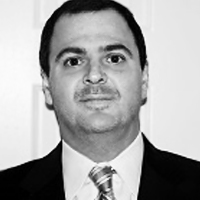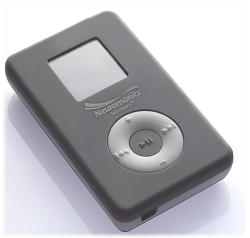Interview with Curtis Amann, Vice President Sales and Marketing, Neuromonics, Inc.
Carolyn Smaka: Curtis, thanks for talking with me today. Tell me about the new Neuromonics Sanctuary™.

Curtis Amann: The Neuromonics Sanctuary is a new entry-level device that offers a simple and flexible process both for the audiologist and the patient. The Neuromonics Oasis and the current version of the Neuromonics Tinnitus Treatment require an extensive follow-up protocol, which is not always indicated for every tinnitus patient. We are really excited to now have the opportunity to offer a solution for the patient who maybe isn’t seeking a long-term protocol, but is seeking situational relief for his or her tinnitus. This addition to the Neuromonics product portfolio allows us to be much more flexible and open our proven process to a much wider variety of tinnitus patients.
Carolyn: How does the Sanctuary device itself differ from the Oasis?
Curtis: The Sanctuary is preprogrammed. All the hearing profiles and all the programs are preloaded into the device. This allows the clinician to fit the patient the same day as evaluation. Sanctuary also has some additional features, including multiple headphone options, as well as added functions, like a sleep timer. I think the most pertinent new features are the ability to have a same-day fitting process and the fact that there is no software involved. For the audiologist, Sanctuary allows for a much more streamlined process in the office.

Carolyn: That sounds great. We know that no two tinnitus patients are the same, so the added flexibility sounds like a great benefit. In terms of candidacy, how do clinicians determine when to recommend the Neuromonics Sanctuary, and when to recommend the Oasis?
Curtis: The Sanctuary candidate is the tinnitus patient who would be on the mild-to-moderate scale of tinnitus. We use the Tinnitus Reaction Questionnaire (TRQ) (Wilson, Henry, Bowen, & Haralambous, 1991) to establish candidacy guidelines. For the Sanctuary patient, we are targeting a TRQ score of 35 and below. The Oasis has much wider candidacy criteria, with TRQ scores of 17 to 70. We have found a lot of variability between patients with a low score and a high score on the TRQ, and that the two groups generally do not require the same level of follow-up or the same approach to treatment.
For patients on the lower end of the spectrum, we can provide a more streamlined approach – one that is aimed at situational relief. In other words, if someone’s tinnitus is bothersome at certain times, as opposed to being constant or invasive, that person would be a candidate for the Sanctuary. Or, a patient who finds his or her tinnitus only disturbing at night, or when sitting in quiet would be a candidate for the Sanctuary. If tinnitus symptoms are debilitating, and impacts an individual’s life almost constantly, that person would be a candidate for the Oasis.
Carolyn: I see there is a bedtime speaker option with the Sanctuary. I would think that would be very useful, as we know that most people with tinnitus will report it is noticeable or worse at night.
Curtis: That is exactly right. Almost all tinnitus patients struggle when it gets really quiet at night and when they are getting ready for bed. We do have an auxiliary speaker accessory option that can be added to the Sanctuary device. It can provide background relief and sound enrichment for the patient while going to bed, and it can also be used during the day, for example, while sitting at a desk and working. The auxiliary speaker option is the perfect way to make the Sanctuary and its stimulus flexible, rather than just being able to listen to it through headphones.
Patients with tinnitus who wear hearing aids often report than when they take their hearing aids off, and there are no sounds to amplify, they really notice their tinnitus. Having the additional sound enrichment process available for those patients is a real benefit.

Carolyn: Curtis, you mentioned that the Sanctuary is pre-programmed, which sounds like a convenient timesaver. Because it is pre-programmed, is it one-size-fits-all or are there options for customizing it?
Curtis: That is a great question. While the Sanctuary is preprogrammed, it contains a variety of preprogrammed options so it can be customized. There are multiple hearing profiles contained within the device. The audiologist selects the most appropriate profile for each patient, based on the audiogram. There is flexibility within the profiles as well. These hearing profiles are a culmination of research over the past six years, looking at audiograms to determine the profiles that will fit most patients.
Another important thing to note is that the profiles in Sanctuary automatically contain the ultra-high frequencies. One of the foundations of the Neuromonics Tinnitus Treatment is the concept of stimulating over a broad frequency range. In the past, you had to have high frequency audiometry to be able to fit an Oasis patient. That is not the case with the Sanctuary. There are no additional equipment or procedures required in order for an audiologist to offer the Sanctuary device to patients.
Carolyn: What are some of the factors that influence how long tinnitus treatment will take?
Curtis: There are many factors that influence the duration of treatment. One is the level of tinnitus disturbance the patient is experiencing. Another is the degree to which the patient is compliant with the chosen treatment modality. The higher the disturbance level, the longer treatment typically takes. When compliance is low, the length of treatment time will increase.
With the Oasis, for instance, are separate phases of treatment. The first phase is a conditioning phase in which we are working on the emotional element of treating tinnitus. During this phase, we are calming the body down, using music to engage the limbic system so that we can provide a comfortable, relaxing environment in which to deliver the treatment. With the current protocol, we spend a couple months focusing just on the emotional response.
The second phase is a desensitization phase in which we use music to systematically desensitize the patient to their tinnitus perception over time. During this phase, we are targeting long-term reduction in tinnitus awareness and disturbance. That process can take anywhere from 6 to 10 months, depending the factors mentioned above as well as audiological factors such as the degree of hearing loss and/or if the patient has any sound sensitivity issues.
With the Sanctuary, the goal is to provide the patient with a management program that focuses on tinnitus relief as opposed to a long-term treatment protocol. The Sanctuary delivers the same acoustic signal as Phase 1 of the Oasis treatment protocol. It targets the body’s limbic system, and works on the emotional center and the negative association with tinnitus. The Sanctuary delivers a high level of interaction, providing relief for the patient while listening to the device. Patients who are less disturbed by their tinnitus will get almost immediate relief in those instances where they need it.
With the Oasis, our clinical data shows that 70% of the patient’s overall benefit with the two-phase treatment process happens during Phase 1. When you tap into the negative emotional center and break the negative association with tinnitus, patients tend to get out of the gate and do very well early in the process. That translates very well to what the Sanctuary device is doing. It provides a sense of relief and control to give the patient benefit early on. Neuromonics is very excited about being able to bring that element of the treatment to a broader patient population.
Carolyn: So it sounds like with Sanctuary, the foundation and philosophy haven’t changed. You are now delivering the same stimulation in a bit of a different fashion, to benefit a wider variety of patients.
Curtis: That’s right.
Carolyn: I appreciate you taking the time to provide us an overview of the Sanctuary today. Best wishes for its continued success.
For more information, please visit https://www.neuromonics.com/ or the Neuromonics Expo Page on AudiologyOnline.
References
Wilson, P., Henry, J., Bowen, M., & Haralambous, G. (1991). Tinnitus reaction questionnaire: psychometric properties of a measure of distress associated with tinnitus. Journal of Speech and Hearing Disorders, 34, 197-201.

